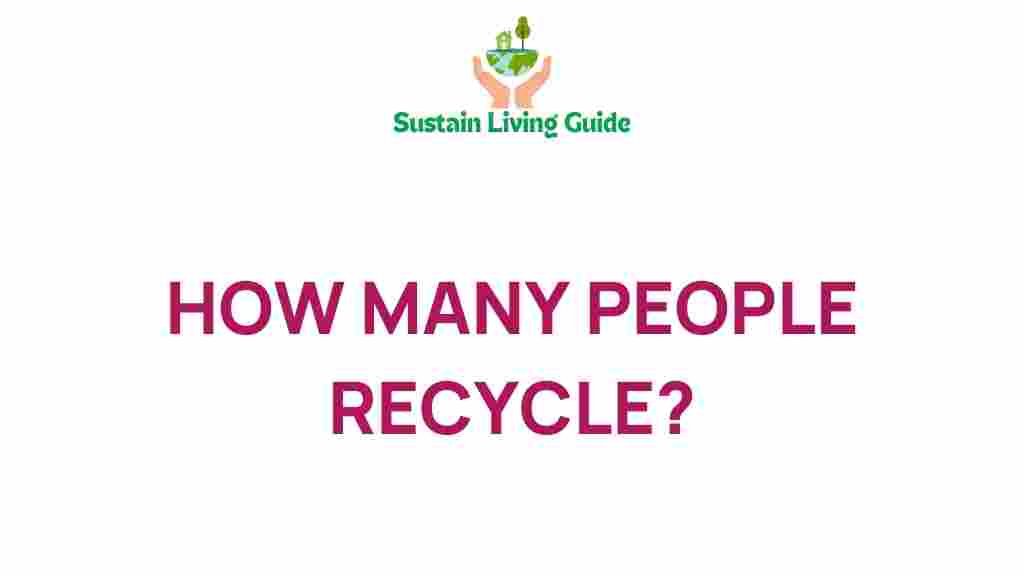The Surprising Truth About How Many People Recycle Today
Recycling has become a household term, but how many people actually participate in this vital activity? With growing concerns over environmental sustainability, understanding recycling habits is crucial. This article explores the surprising truth about recycling rates, the factors influencing these rates, and practical advice on improving recycling efforts.
The Current State of Recycling
As of recent studies, approximately 35% of Americans recycle regularly. While this number may seem encouraging, it also reveals a significant portion of the population that does not engage in recycling practices. Let’s delve deeper into the statistics surrounding recycling, revealing both the positive strides we’ve made and the challenges that persist.
- In 2021, the recycling rate in the United States was around 35.4%.
- Only 9% of plastic waste is recycled globally.
- Europe has a higher recycling rate, with an average of 47% of waste recycled.
Factors Influencing Recycling Rates
Understanding why some individuals choose to recycle while others do not can be complex. Several factors play a role in these decisions:
- Education: Awareness and knowledge about recycling processes significantly impact participation rates.
- Convenience: Access to recycling bins and easy-to-understand guidelines can encourage recycling.
- Incentives: Programs that reward individuals for recycling can boost participation.
- Community Engagement: Local initiatives and campaigns can foster a culture of recycling.
Step-by-Step Guide to Recycling Effectively
Recycling is not just about tossing items in a bin; it involves understanding what can and cannot be recycled. Here’s a straightforward guide to recycling effectively:
Step 1: Know What You Can Recycle
Each community has different rules about what materials can be recycled. Common recyclable items include:
- Paper and cardboard
- Glass bottles and jars
- Certain plastics (look for recycling symbols)
- Aluminum cans
Step 2: Clean Your Recyclables
Before placing items in the recycling bin, ensure they are free from food residue. Here are some tips:
- Rinse containers with water.
- Remove labels if required by your local program.
- Flatten cardboard boxes to save space.
Step 3: Separate Your Waste
Properly separating recyclables from non-recyclables is crucial. Use designated bins to avoid contamination. Consider labeling bins to make it easier for family members or guests to participate.
Step 4: Stay Informed
Regularly check your local recycling guidelines as they can change. Many cities have resources online or community workshops to help residents stay informed. You can find more information about your local recycling policies here.
Troubleshooting Common Recycling Issues
Even the most diligent recyclers may encounter challenges. Here are some common issues and how to resolve them:
Problem 1: Confusion Over What Can Be Recycled
If you’re unsure about whether an item is recyclable:
- Check the recycling symbol on the item.
- Consult your local waste management website for guidance.
- Consider using apps designed to help you identify recyclables.
Problem 2: Insufficient Recycling Facilities
If recycling options are limited in your area, consider:
- Contacting local authorities to express your concerns.
- Creating or joining community groups focused on improving recycling access.
- Looking for local drop-off centers that accept recyclables.
Problem 3: Contamination of Recyclables
Contamination can lead to entire batches of recyclables being sent to landfills. To avoid this:
- Thoroughly clean your recyclables.
- Educate others in your household about what can and cannot be recycled.
- Use visual aids or reminders near your recycling bins.
The Impact of Recycling on the Environment
Recycling plays a crucial role in reducing waste and conserving resources. Here are some significant environmental benefits:
- Conserves Natural Resources: Recycling reduces the need for virgin materials, helping to preserve forests, water, and minerals.
- Reduces Greenhouse Gas Emissions: Recycling leads to lower energy consumption, significantly reducing emissions.
- Saves Energy: Producing new products from recycled materials typically uses less energy than creating them from raw materials.
Conclusion: Moving Forward with Recycling
The surprising truth about how many people recycle today reveals both progress and room for improvement. With only 35% of Americans participating regularly, there’s much work to be done. By implementing effective recycling practices, educating ourselves and others, and advocating for better recycling resources, we can increase participation and make a significant impact on our environment.
Remember, every small effort counts. Together, we can foster a culture of recycling that benefits our planet. For more information on recycling practices and community initiatives, visit this resource.
This article is in the category Waste and created by SustainLivingGuide Team
